For years, WordPress has been the default.
More than 43% of the web runs on it. It’s not just a CMS — it’s an ecosystem, a movement, a legacy.
But here’s the thing about legacies: they’re either built on or left behind.
WordPress may still lead the web in raw numbers, but scratch beneath the surface and a different picture emerges.
📉 Search interest has stalled.
📉 Market share growth is flatlining.
📉 Nimble, modern tools are gaining traction in key verticals.
So what’s really happening? Is WordPress dying? Or is this just another blip?
We dove into the search data, platform shifts, and expert voices behind the scenes — and what we found might surprise you.
WordPress Isn’t Collapsing, But It’s Not Untouchable, Either
The web is changing — fast.
And the truth is, WordPress doesn’t dominate in every corner anymore.
✅ Shopify is creeping into content-first spaces.
✅ Webflow, Bubble, and Framer are redefining MVP development.
✅ Users want instant, integrated, low-maintenance platforms.
As Vikas Singhal, the founder of InstaWP, explains:
“WordPress isn’t slow. It’s just big.“
And that bigness — the plugins, the options, the sheer weight of choice — is starting to show.
It’s not a cause for panic. But it is a signal.
Because in today’s landscape, agility wins. And the builders who don’t adapt? They’re already falling behind.
The Real Challenge? WordPress’s Own Complexity
Ironically, WordPress’s biggest challenge might not be external competition — it’s internal chaos.
Overlapping plugins, performance issues, bloated themes — what used to be flexible now often feels fragmented.
In a world where user experience is everything, that’s a problem.
And it’s not just about performance — it’s also about how modern users interact with builders.
Verdi Heinz, Community Manager at Elementor, adds:
“As web creators, the challenge isn’t just keeping up with technology but anticipating how people will consume and interact with content in the future.“
Right now, that seamlessness is exactly what WordPress lacks.
It’s Not the End. It’s a Reboot.
Despite all that, WordPress isn’t going anywhere — not if it leans into its strengths.
🔓 Total control.
🌍 A global open-source community.
🧱 Modular flexibility.
🔌 The largest ecosystem of tools, themes, and extensions on the planet.
As Nathan Wrigley, WordPress podcaster at WP Builds and WP Tavern, points out:
“The community of the people creating the software and maintaining the community is the single biggest asset that WordPress has.“
That ecosystem — the people, the passion, the power to build anything — still matters.
But it can’t rely on inertia. Not anymore.
As Jonathan Wold, Co-founder of Guildenberg, states:
“WordPress is around to stay for quite some time, but there’s a lot of opportunity to improve how you build in WordPress and how you do business in WordPress, and it’s important to be curious about that, to ask questions, to stay on top of what’s going on.“
Because while WordPress remains powerful, the market is moving — and fast.
So the question is: Are you adapting with it?
Or are you still building like it’s 2015 — for users who’ve already moved on?
👉 Download Our e-Book
Real numbers. Insider quotes. No fluff.
Let’s talk about what no one else is saying — and where this ecosystem is really heading next.

